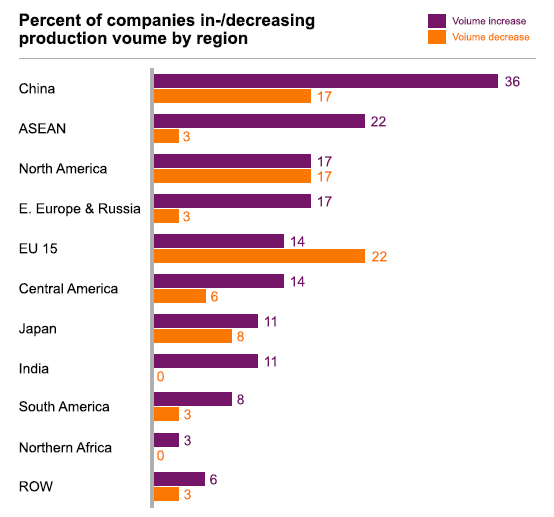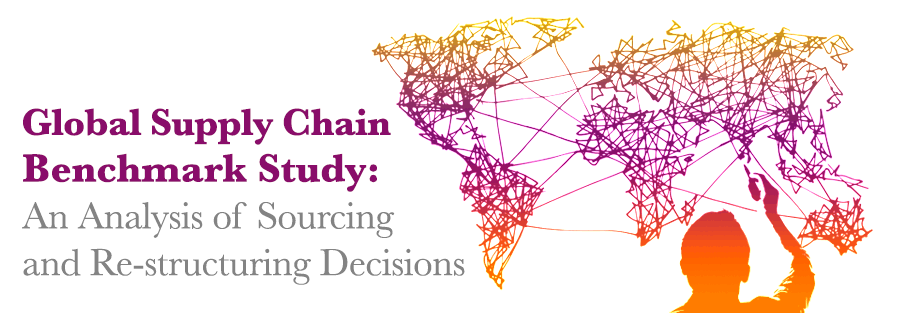Global Supply Chain Benchmark Study: An Analysis of Sourcing and Re-structuring Decisions
In both industry and academia, it is common knowledge that many of the world’s largest manufacturers have been rethinking the decades-old practice of offshoring—and most often outsourcing—production to low-cost global suppliers.
What is less well understood are the reasons why and the true extent to which these manufacturers are reversing or redirecting their global supply chains and sourcing strategies. It’s fair to assume that factors such as rising labor costs in low-cost countries, shifts in the sources and cost of energy and changes in government policy affecting taxes, trade agreements, incentives and regulations are major contributors to the “why;” but determining what is actually happening is more complicated. The debate concerning these issues is highly political, often misinformed and most of what we “know” about what is occurring is based on anecdotal evidence.
This is why we, along with a consortium of faculty at leading business schools, have developed the Global Supply Chain Benchmark Study to examine the current status and rationale of decision making on the part of companies to source materials, assembly, processing and production on a global basis*. The goal is to benchmark current practices with regard to the following three questions:
- What global sourcing decisions have been made and what decisions are being contemplated?
- What are the drivers of these decisions?
- What is their observed or expected impact?
A first phase of data collection for the Benchmark project, which included 36 responses from leading companies in a wide range of industries, was completed last year. The data analysis yielded interesting insights into patterns of current sourcing decisions and the principal reasons companies are adopting these patterns.
For example, although many business analysts and media outlets proclaim that companies are increasingly “reshoring” their manufacturing activities—most often referring to the return of production to North America—according to our survey results, China leads all regions in production volume growth by a substantial margin. The reasons for moving production to China, however, do seem to be changing. They include: cost conscious companies moving labor-intensive products mostly from Europe to China, companies with capital intensive production transferring manufacturing to China for quality reasons and an expectation of an increasing relevance of China as a consumer market.

A few other observations from our Phase 1 results:
- Talk about the return of manufacturing to the U.S. appears to be just that—talk. Our research revealed that the rate of production increase and decrease in the region is equal.
- EU 15 countries are losing ground. Europe is the only region with more companies divesting than investing, primarily driven by costs but also by market reasons. Even automated and/or high-value production has moved out of Europe.
- While China is still the most attractive region for sourcing production, it is also among the top countries for volume decrease. Companies leaving China do so for total cost reasons. ASEAN countries emerge as low-cost destinations to serve Asian markets.
- For European companies, North America represents a lower-cost and lower-risk alternative compared to production at home.
- For non-American markets, companies are divesting in North America in favor of locations closer to demand.
While our response pool is somewhat limited, the results paint a clear enough picture to infer that anecdotal evidence and subjective market analysis may not be giving us a true picture of the manufacturing sourcing and supply chain restructuring activity that is underway.
We can see there is a wide range of decision drivers that have been mentioned. Often a particular driver, such as market changes or costs, has been given a high priority for conflicting decisions (e.g. to shift or not to shift production). This suggests that companies are not being motivated by a particular driver, such as lower labor costs, for adopting a particular policy (e.g. outsource to China). Rather, they are evaluating complex tradeoffs that affect their global performance through their impact on local performance metrics such as the landed cost for each product in each market.
The survey project has now entered a second phase where the sample of companies is being expanded extensively. We hope to be able to share analysis of the full set of results by December 2015.
*The term “production” here refers to activities conducted by a firm which results in an end product being completed and made available for distribution to customers. It could include the following:
- Final assembly of manufactured products composed of discrete parts
- Processing of products in process industry settings
- Assembly or fabrication of parts or sub-assemblies which are sold as the output of the firm
Related Resource:
- Book: Designing and Controlling the Outsourced Supply Chain by Professor Andy Tsay, Leavy School of Business, Santa Clara University
